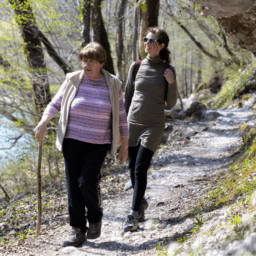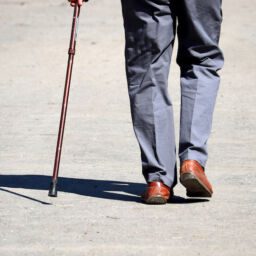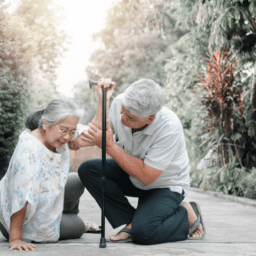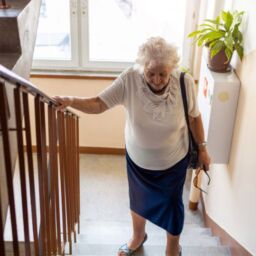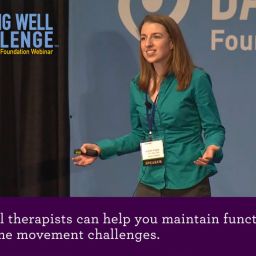Falling is an ongoing concern for many people with Parkinson’s, and they often seek strategies to reduce their risk.
Interestingly, the thoughts and ideas that occupy your mind while you walk can have a substantial impact on your gait.
Dr. Penko and her colleagues from the Cleveland Clinic recently published a research study that we funded in the journal Neuroscience that examined the impact of different types of cognitive tasks on gait function, such as walking. Their work supports the “Limited Resources Hypothesis” which states that cognitive and motor tasks compete for limited, valuable brain resources.
Under dual-task conditions, when you’re asked to walk while also working through a cognitive task such as problem-solving, performance on one of these tasks will suffer as there are less available resources for the brain to recruit and use.
It is thought that this disruption occurs because the brain pathway responsible for motor functions is parallel to and overlaps with the pathway for cognitive functions. As these pathways pass through the basal ganglia, an area impacted in individuals with Parkinson’s, these pathways compete for resources. When your behavior activates both pathways (such as walking while performing a cognitive task), the basal ganglia is unable to sufficiently process both tasks and performance on one will suffer. Thus, this competition may increase the risk of falling.
In this recently published study, Dr. Penko and her colleagues studied twenty-three individuals with mild to moderate Parkinson’s, many of whom had experienced a fall in the last year. The researchers asked participants to walk on a treadmill while thirty-one sensors measured their gait.
At the same time, participants were asked to complete a variety of cognitive tasks such as:
- recalling a list of numbers said aloud
- naming words that begin with the same letter as a word given
- counting down from a three-digit number by subtracting sevens
Regardless of the type of cognitive task they were asked to perform, participants took significantly shorter steps and walked at slower speeds, which can be strong predictors of falling in individuals with Parkinson’s.
Interestingly, Dr. Penko found that the level of difficulty of the cognitive task did not matter. If the cognitive task was hard or easy, gait was impacted. This suggests that cognitive tasks in general place enough demand on the limited resources available that motor functions will be impacted negatively.
If you’re concerned about falling, Dr. Penko’s work suggests that your risk could be reduced by strategically limiting cognitive demands while walking because in doing so you’re reserving more resources for the motor movement of walking.
It’s important to note that every study has limitations. In this work, the researchers studied individuals with mild to moderate Parkinson’s who were able to walk for 300 feet without assistance. It’s unknown if these results would also hold true for individuals with more severe Parkinson’s.
Further, individuals with a Parkinson’s specific surgical intervention (e.g., deep brain stimulation) were not included in this study; so, it remains unclear how these dual-task conditions would impact these individuals. Finally, Penko and her colleagues studied gait on a treadmill which can mimic real-life scenarios; however, motor function in a controlled setting such as a laboratory is not a direct replication of the function experienced in everyday life.
This recent research is similar to Dr. Penko’s earlier work showing that individuals with Parkinson’s can experience instability in their posture when asked to perform a cognitive task. This also supports the Limited Resources Hypothesis. Taken together, Dr. Penko and her colleagues provide valuable insight into the relationship between cognitive functions and motor functions for people with Parkinson’s. This research could inform future efforts to develop exercise recommendations or physical and occupational therapies to improve gait.
Of course, it’s not possible to limit all cognitive demands while walking, but the implications of this research highlight the potential benefit of limiting these demands as much as possible. Perhaps it’s worth saving a conversation with a care partner about a problem you’d like to solve until you’re seated and not walking. Or to wait to try and remember the date of your next doctor’s appointment until after you’re done walking. The mind and the body are closely linked; therefore, these and similar strategies may reduce your risk of falling.
Want More Practical Articles Like This?
Much more can be found in a powerful new edition of Davis Phinney Foundation’s free Every Victory Counts® manual. It’s jam-packed with up-to-date information about everything Parkinson’s, plus an expanded worksheets and resources section to help you put what you’ve learned into action. Color coding and engaging graphics help guide you through the written material and point you to complementary videos, podcasts and other materials on the Every Victory Counts companion website. And, it is still free of charge thanks to the generosity of our sponsors.
Request your copy of the new Every Victory Counts manual by clicking the button below.



